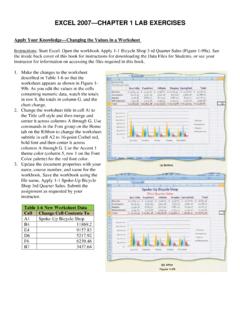Transcription of Texas Instruments Robotics System Learning Kit The Maze ...
1 Preface Texas Instruments Robotics System Learning Kit The Maze Edition Preface The ultimate goal of the Learning kit is to design, build, and test a robot This is an embedded systems curriculum; hence you will interface System capable of solving complex tasks. One possible robot is shown in numerous devices to the MSP432 microcontroller. In particular, you will Figure 1. Example challenges include exploring a maze, racing interface LEDs, switches, a line sensor, DC motors, tachometers, and an autonomously, finding an object, and following a line. However, it is not LCD. Your microcontroller hardware/software skills will include pulse- the final robot that matters, but the educational journey that discovers a width modulation (PWM), flash read-only memory, periodic timers, edge- wide range of engineering principles along the way.
2 Rather than just triggered interrupts, digital to analog converter (DAC), analog to digital providing the robot kit and a challenge to solve, this curriculum follows converter (ADC), synchronous serial communication, and asynchronous an educational road map that intentionally exposes deep Learning along serial communication. the way. A significant component of the curriculum involves software development. You will develop software skills in multithreading, data structures, debugging, linked lists, semaphores, and first in first out (FIFO) queues. You will learn how to use a logic analyzer for interface testing, and thread profiling. This is a lab-based curriculum. However, there are numerous fundamental concepts to master, such as the Nyquist Theorem, the Central Limit Theorem, digital filtering, and Little's Theorem.
3 The overriding theme of this curriculum is to teach systems design in a bottom up fashion. We begin with simple components so that you learn fundamentals. A System is created by combining multiple components with the appropriate hardware and software interfaces. Once you master the fundamentals of one component, its operation can be abstracted into a set of high-level functions. Separating how a component works (low- level implementation) from what it does (high-level abstraction) is the key for developing complex systems. Obviously, the most important System in this curriculum will be the robot. However, there will be other systems like a security System , a traffic light control System using a finite state machine, Bluetooth Low Energy (BLE) communication System , and the Wi-Fi-based internet of things (IoT) System .
4 Figure 1: TI-RSLK Maze Robot A System is comprised of subsystems connected together to solve a unified objective. An effective approach to teaching systems is to begin The EE skills you will learn include voltage, current, power, energy, with very simple components. First, one completely understands how the batteries, resistors, capacitors, transistors, diodes, and DC motors. You component works. Second, one creates an abstraction that separates will learn how to use a voltmeter, an ohmmeter, a current meter, and an what is does from how it works. Third, components are interfaced oscilloscope. together to create a new more complex System . 2 Texas Instruments Robotics System Learning Kit: The Maze Edition SWRP242. Preface The terms System , subsystem, and component are used here (or teach).
5 Challenges are sorted by the set of sensors and actuators interchangeably. that are required. As you can see from Figure 2, there are twenty modules in the Robot Features (Full set, Advanced Kit) : curriculum. Each module is relatively independent, and you can thread Robot Chassis with 2 DC motors and wheels together modules to create a particular Learning experience for your 6 AA NiMH batteries students. Motor driver and power distribution board ( MDPD) with motor drivers and voltage regulator to power your System 3 IR distance sensors Each module has: 6 touch/bump sensors Introduction to module (1 page) 8 line sensors o Overview 2 tachometers o Educational objectives Tachometer o Prerequisites, bullet list linking to other modules BLE or Wi-Fi o References Class lecture PowerPoint slides (one to three files) Course prerequisites: Screen capture video with audio of PowerPoint (one to three Algebra and college physics videos).
6 Basic knowledge of computers and architecture Class activity, homework exercises or practice problems. C programming Lab document Hardware needed, o BOM excel file of parts o Circuit diagrams in CircuitMaker. Lab solution for faculty to access, not available to students. One to three videos of finished lab Quizzes Quiz solutions for faculty to access, not available to students. The most important document is the lab manual. Performing labs results in the design, construction, and testing of the robot System . To find the circuit diagrams, create an account in Circuit maker. Launch the application, under projects select Tags, and search MSP432. You will find starter circuits for each lab that has hardware. The robot challenge document lists some possible final projects for the course.
7 Most users of this curriculum will pick and choose a subset of the modules, allowing the user to focus on which concepts they wish to learn 3 Texas Instruments Robotics System Learning Kit: The Maze Edition SWRP242. Preface Voltage Power DC Tachomet Control (M2) (M5) Motors er Systems (M12) (M16) (M17). Software Switches SysTick Debugging Timers CCS (M1) Design GPIO (M6) FSM (M7) & LED real-time (M9) (M13). (M4) (M8) systems(M1. 0). Assembly Data Edge LCD (M11) Acquisitio Interrupts (M3) UART n (M14). (M18) (M15). BLE (M19). Wi-Fi (M20). Figure 2. TI-RSLK: Learning Modules & Curriculum Pathways 4 Texas Instruments Robotics System Learning Kit: The Maze Edition SWRP242. Preface Modules: Theory: Using typical input parameters for the robot, perform, <CCS> 1.
8 Running Code on the LaunchPad using CCS logical operations of AND, OR, EOR, shift, add, subtract, Prerequisites: none multiply, divide, variables, and functions Equipment: LaunchPad Lab: Simple C programming converting ADC-inputs to calibrated Theory: how to install and configure CCS for this class distance. Given three distance measurements, implement Lab: installing CCS, MSP432 drivers, and running the a classification algorithm to interpret the robot world TExaSdisplay logic analyzer <Power> 5. Battery and Voltage Regulation Prerequisites: <Voltage_Current>. <Voltage_Current> 2. Voltage, Current and Power Motivation: Robot is battery powered; robot motor controller Prerequisites: none board has power regulation Motivation: The hardware interfaces for the robot involve Tools: Voltmeter, current meter, ohmmeter voltage, current and power Equipment: Two power resistors 5W 10-ohm resistor and 22- Tools: Voltmeter, current meter, ohmmeter, signal generator, ohm 5W resistor, rechargeable battery ( ) is , oscilloscope 2A-hr battery lasts 4hr Robot with power regulation/motor Equipment: 220 470 22k 33k ohm resistors, 10uF driver board capacitors, voltage supply, 10-mA LED and 2-mA LED Theory: Resistor, Ohm's Law Theory: Resistor, Ohm's Law, LED voltage current relationship Theory: total energy in battery voltage current relationship while Lab.
9 Characterize LED, Measure Reactance V>regulator minimum Lab: battery power, calculations, measurements <Assembly> 3. ARM Cortex M. Prerequisites: <CCS> <GPIO> 6. GPIO MSP432. Motivation: teaching assembly will help understand how it works, Prerequisites: <Logic>. and how to debug Motivation: robot line sensor is needed for line following Tools: CCS Tools: CCS Voltmeter, oscilloscope, Equipment: LaunchPad (20-instruction subset of Cortex M) Equipment: LaunchPad, integrated line sensor Theory: machine code, registers, execution, bus, memory, Theory: conversion light to voltage, direction registers, simple I/O input, output, friendly (This connects to the maze robot). Lab: assembly language programming Lab: input from line sensor, output to build-in LED.
10 Installing and running assembly language Input line sensor, detect position relative to a black line on a white field <SoftwareDesign> 4. Software Design using MSP432. Prerequisites: <CCS> <FSM> 7. Finite State Machines Motivation: most of the labs are C programmed on the MSP432, Prerequisites: <Logic> <GPIO>. C programming is a prerequisite to the class, but an Motivation: FSMs are an effective solution to robotic functions introduction to C code on the MSP432 is appropriate Tools: CCS. Tools: CCS Equipment: LaunchPad using built-in switches and LEDs Equipment: LaunchPad using built-in switches and LEDs Theory: loops, decisions Lab: Very simple C programming, 2-input, 2 output FSM. 5 Texas Instruments Robotics System Learning Kit: The Maze Edition SWRP242.














